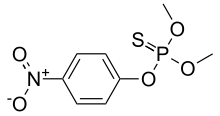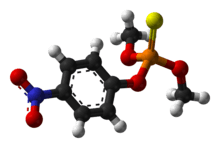Parathion methyl
Parathion methyl, or methyl parathion, is an organophosphate insecticide, possessing an organothiophosphate group. It is structurally very similar to parathion-ethyl. It is not allowed for sale and import in nearly all countries around the world, while a few allow it under subject to specified conditions only.
 | |
 | |
| Names | |
|---|---|
| IUPAC name
O,O-Dimethyl-O-p-nitrophenylphosphorothioate | |
| Other names
Azophos, Methyl parathion, O,O-Dimethyl O-4-nitrophenyl phosphorothioate, O,O-Dimethyl-p-nitrophenylthionophosphate | |
| Identifiers | |
3D model (JSmol) |
|
| ChemSpider | |
| ECHA InfoCard | 100.005.501 |
| EC Number |
|
PubChem CID |
|
| RTECS number |
|
| UNII | |
| UN number | 2783 |
CompTox Dashboard (EPA) |
|
| |
| |
| Properties | |
| (CH3O)2P(S)OC6H4NO2 | |
| Molar mass | 263.2 g/mol |
| Appearance | White to tan, crystalline solid or powder[1] |
| Odor | pungent, garlic-like[1] |
| Density | 1.36 g/mL (20°C)[1] |
| Melting point | 37 °C; 99 °F; 310 K[1] |
| Boiling point | 143 °C; 289 °F; 416 K[1] |
| 0.006% (25°C)[1] | |
| Vapor pressure | 0.00001 mmHg (20°C)[1] |
| Hazards | |
| Main hazards | reactive with strong oxidizers and water[1] |
| Lethal dose or concentration (LD, LC): | |
LD50 (median dose) |
67 mg/kg (rat, dermal)[2] 10-25 mg/kg (male rat, oral)[3] 24 mg/kg (female rat, oral)[3] |
| NIOSH (US health exposure limits): | |
PEL (Permissible) |
none[1] |
REL (Recommended) |
TWA 0.2 mg/m3 [skin][1] |
IDLH (Immediate danger) |
N.D.[1] |
Except where otherwise noted, data are given for materials in their standard state (at 25 °C [77 °F], 100 kPa). | |
| Infobox references | |
Trade Names
Penncap-M, Metacide [4]
Safety
People can be exposed to parathion methyl in the workplace by breathing it in, getting it on their skin, swallowing it, or getting it in their eyes. Since it is an acetylcholinesterase inhibitor, symptoms of exposure to parathion methyl include irritated eyes and skin, nausea and vomiting, abdominal pain, diarrhea, salivation, feeling weak and tired, headache, runny nose, tightness in the chest, blurry vision, pupil constriction, irregular heartbeat, muscle twitches (fasciculation), and difficulty breathing.[5][1]
In the United States, the Occupational Safety and Health Administration (OSHA) has not set a legal limit (permissible exposure limit) for parathion methyl exposure in the workplace. The National Institute for Occupational Safety and Health (NIOSH) has set a recommended exposure limit (REL) of 0.2 mg/m3 over an 8-hour workday.[1]
Even though parathion methyl is classified as extremely hazardous, it is not classified as a carcinogen by any global agency.[2]
Classifications and restrictions
Parathion methyl has been restricted for many years. It is classified as Extremely Hazardous (Ia) by the World Health Organization and it is classified as Severely Hazardous by the Rotterdam Convention. It is not allowed for sale and import in nearly all countries around the world, while a few allow it under subject to specified conditions only.[6][7][8][9]
References
- NIOSH Pocket Guide to Chemical Hazards. "#0427". National Institute for Occupational Safety and Health (NIOSH).
- "Skin notation profile: Methyl Parathion" (PDF). NIOSH.
- "Methyl Parathion". 1988 OSHA PEL Project Documentation. NIOSH. 28 September 2011.
- "Methyl Parathion (Penncap-M) - Chemical Profile 4/85". Cornell.edu.
- Journal of Toxicology and Environmental Health B Critical Review (2003): Methyl parathion: a review of health effects., PubMed
- CABI Plantwise: Plantwise Pesticide Red List
- WHO (2010): The WHO Recommended Classification of Pesticides by Hazard, p5, IPCS
- Rotterdam Convention: Annex III Chemicals
- Annex III Chemicals: Methyl-parathion (Emulsifiable concentrates (EC) at or above 19.5% active ingredient and dusts at or above 1.5% active ingredient), Rotterdam Convention